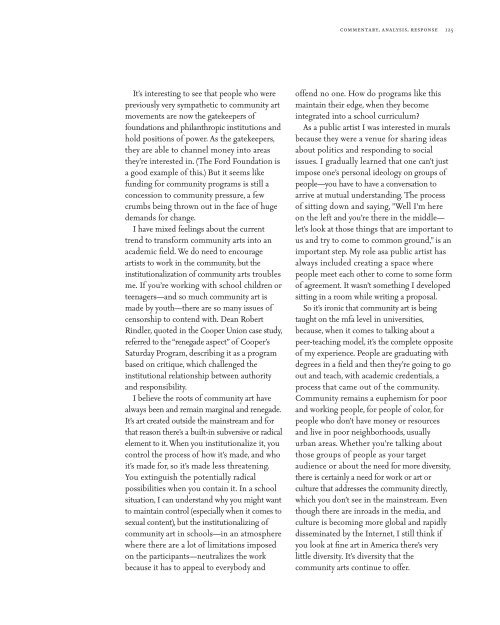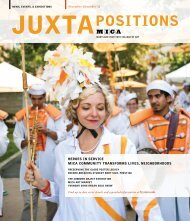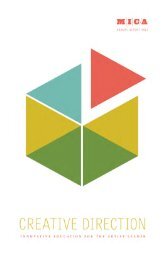art/vision/voice - Maryland Institute College of Art
art/vision/voice - Maryland Institute College of Art
art/vision/voice - Maryland Institute College of Art
You also want an ePaper? Increase the reach of your titles
YUMPU automatically turns print PDFs into web optimized ePapers that Google loves.
It’s interesting to see that people who were<br />
previously very sympathetic to community <strong>art</strong><br />
movements are now the gatekeepers <strong>of</strong><br />
foundations and philanthropic institutions and<br />
hold positions <strong>of</strong> power. As the gatekeepers,<br />
they are able to channel money into areas<br />
they’re interested in. (The Ford Foundation is<br />
a good example <strong>of</strong> this.) But it seems like<br />
funding for community programs is still a<br />
concession to community pressure, a few<br />
crumbs being thrown out in the face <strong>of</strong> huge<br />
demands for change.<br />
I have mixed feelings about the current<br />
trend to transform community <strong>art</strong>s into an<br />
academic field. We do need to encourage<br />
<strong>art</strong>ists to work in the community, but the<br />
institutionalization <strong>of</strong> community <strong>art</strong>s troubles<br />
me. If you’re working with school children or<br />
teenagers—and so much community <strong>art</strong> is<br />
made by youth—there are so many issues <strong>of</strong><br />
censorship to contend with. Dean Robert<br />
Rindler, quoted in the Cooper Union case study,<br />
referred to the “renegade aspect” <strong>of</strong> Cooper’s<br />
Saturday Program, describing it as a program<br />
based on critique, which challenged the<br />
institutional relationship between authority<br />
and responsibility.<br />
I believe the roots <strong>of</strong> community <strong>art</strong> have<br />
always been and remain marginal and renegade.<br />
It’s <strong>art</strong> created outside the mainstream and for<br />
that reason there’s a built-in subversive or radical<br />
element to it. When you institutionalize it, you<br />
control the process <strong>of</strong> how it’s made, and who<br />
it’s made for, so it’s made less threatening.<br />
You extinguish the potentially radical<br />
possibilities when you contain it. In a school<br />
situation, I can understand why you might want<br />
to maintain control (especially when it comes to<br />
sexual content), but the institutionalizing <strong>of</strong><br />
community <strong>art</strong> in schools—in an atmosphere<br />
where there are a lot <strong>of</strong> limitations imposed<br />
on the p<strong>art</strong>icipants—neutralizes the work<br />
because it has to appeal to everybody and<br />
commentary, analysis, response 125<br />
<strong>of</strong>fend no one. How do programs like this<br />
maintain their edge, when they become<br />
integrated into a school curriculum?<br />
As a public <strong>art</strong>ist I was interested in murals<br />
because they were a venue for sharing ideas<br />
about politics and responding to social<br />
issues. I gradually learned that one can’t just<br />
impose one’s personal ideology on groups <strong>of</strong><br />
people—you have to have a conversation to<br />
arrive at mutual understanding. The process<br />
<strong>of</strong> sitting down and saying, ”Well I’m here<br />
on the left and you’re there in the middle—<br />
let’s look at those things that are important to<br />
us and try to come to common ground,” is an<br />
important step. My role asa public <strong>art</strong>ist has<br />
always included creating a space where<br />
people meet each other to come to some form<br />
<strong>of</strong> agreement. It wasn’t something I developed<br />
sitting in a room while writing a proposal.<br />
So it’s ironic that community <strong>art</strong> is being<br />
taught on the mfa level in universities,<br />
because, when it comes to talking about a<br />
peer-teaching model, it’s the complete opposite<br />
<strong>of</strong> my experience. People are graduating with<br />
degrees in a field and then they’re going to go<br />
out and teach, with academic credentials, a<br />
process that came out <strong>of</strong> the community.<br />
Community remains a euphemism for poor<br />
and working people, for people <strong>of</strong> color, for<br />
people who don’t have money or resources<br />
and live in poor neighborhoods, usually<br />
urban areas. Whether you’re talking about<br />
those groups <strong>of</strong> people as your target<br />
audience or about the need for more diversity,<br />
there is certainly a need for work or <strong>art</strong> or<br />
culture that addresses the community directly,<br />
which you don’t see in the mainstream. Even<br />
though there are inroads in the media, and<br />
culture is becoming more global and rapidly<br />
disseminated by the Internet, I still think if<br />
you look at fine <strong>art</strong> in America there’s very<br />
little diversity. It’s diversity that the<br />
community <strong>art</strong>s continue to <strong>of</strong>fer.
















